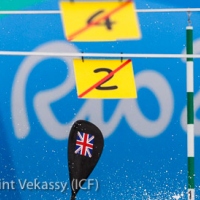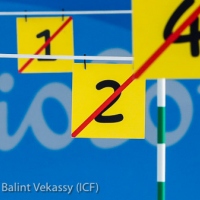Canoe slalom technique and terminology
Today’s attention shifts to describing features of the slalom course and the techniques used to negotiate it. You can refer to the last two posts exploring the kayak classes and canoe classes.
The basics of canoe slalom techniques
The goal for the slalom paddler is to race as fast as possible from the start line to finish line, negotiating up to 25 slalom gates without touching them. The gates must be negotiated in numerical order and as downstream gates identified with green and white poles and upstream gates identified by red and white gates.

A later post explains the rules and judging. A 2-second penalty is incurred for touching one or both poles of a gate and 50 seconds is added to the run time for missing or incorrectly negotiating the gate.
Ideally, the green gates are positioned in the current of the river and the red and white gates are positioned in slack water behind obstructions called eddies.
In Olympic competition, there should be 18-25 gates of which at least 6 must be upstream, identified with red and white poles.
The course designer must ensure the course design is balanced to challenge all competitors equally. The course needs to be designed so that all four classes of paddler to successfully complete it. Good course design offers paddlers different options on how to complete in the fastest and cleanest way. Paddlers will use a full combination of forward, backwards, turning and even rolling on the Deodoro whitewater.
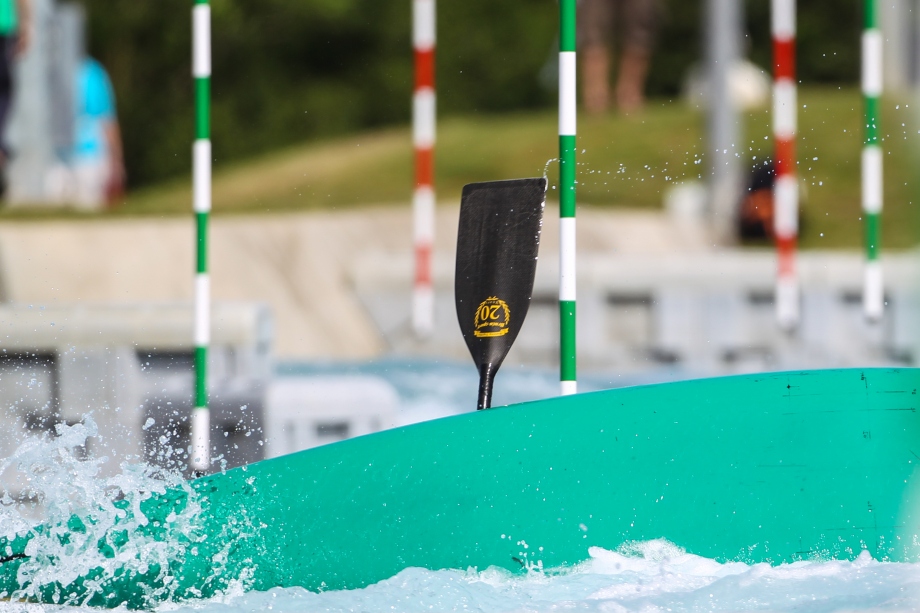
All four classes compete on the same sequence of gates. There is a core set of slalom gate moves, which are described below:
The breakout is the technique used to negotiate the upstream gate positioned in an eddy. The paddler needs to manoeuvre from the downstream current into the eddy, through the gate and back into the downstream current. Simple! Well not quite. Slalom paddlers will have spent thousands of hours in a kayak practising this single manoeuvre by the time they reach the Olympics. It is possible to gain or lose significant seconds over your competitors based on how well or tightly this is performed. The ultimate is to paddle hard tight behind the gate, use one turning stroke to turn while negotiating the gate and pull yourself immediately back into the downstream current. This is much more achievable in C1s and latest kayaks. It does take lots of practice, balance and advanced whitewater skills. I recommend watching the paddlers helmet because the best slalom paddlers are never stationary but maintain a certain amount of boat speed and momentum.
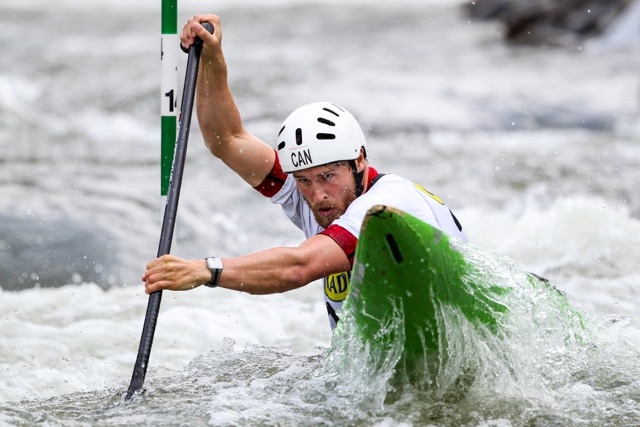
Sometimes, two upstream gates are positioned on opposite sides of the river in numerical order and the slalom paddler can use a technique called ferry gliding or surfing to paddle from one side of the current to the other without being washed downstream.
In canoe slalom the stroke used to negotiate the upstream gate is a bow rudder, accompanied by powerful turning/ sweep strokes. The techniques for doing an upstream depend on the position of the upstream red and white gate within the eddy. In essence, the goal is to approach the upstream wide in and exit tight, trying to avoid dropping too far below the upstream gate on entering the eddy or spending too much time in the eddy above the gate after exiting.
The stagger or offset is a sequence of green and white downstream gates spread across the width of the current. This is much tougher than on it appears; without touching any of the gates, especially on whitewater!
If the stagger is too tight then the paddler may have to spin their kayak (or canoe) around before paddling through the gate. The good slalom paddler will define their line through the stagger gates so they can maximise their boat speed.
In this simplistic view, breakouts are always in perfect static eddies and downstream gates are always in the current. Well, that would be too easy so the course designers will test paddlers but placing upstream gates so that there may be some current flowing down through them. Downstream gates can be placed in the eddy, so this challenges the athlete to keep the kayak or canoe running downstream when it naturally wishes to turn around. Let me explain, when a kayak paddles from the current into an eddy at a 45-degree angle, the water at the front of the kayak is stationary, while the water affecting the back of the kayak is moving downstream. This causes the back of the kayak to overtake the front and the kayak turns round to point upstream. Considerable time can be lost on the breakout gates.
There are some great resources now available to learn the basics of whitewater paddling and slalom techniques. These include Scott Shipley’s great book ‘Every Crushing Stroke’, Bill Endicott’s legendary books ‘To Win the Worlds’ and the ‘Ultimate Run’, as well as YouTube of course. Although the sport and boat design has evolved the basics of good whitewater paddling technique and the common mistakes have changed little!
Advanced canoe slalom techniques – making the difference
In his excellent book Outliers, author Malcolm Gladwell presents 10,000 hours as a tipping point towards mastery. These Olympic athletes have likely spent 10,000 hours in a kayak or canoe. Gladwell’s book may also help point to why most World & Olympic champions are in their late 20’s because at that point they have reached 10,000 hours. So much of advanced technique comes from that incredible comfort zone from being at one with the boat and familiar with whitewater.
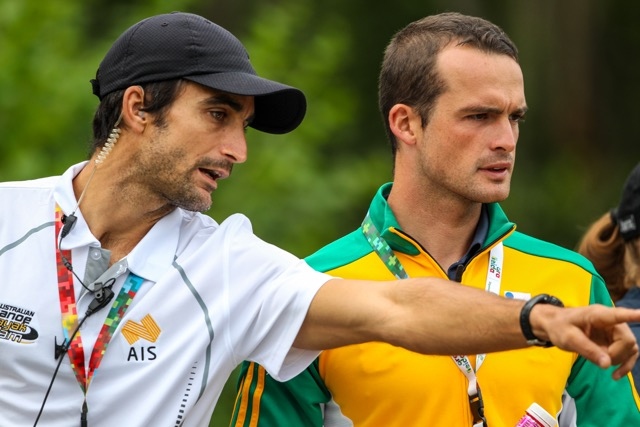
Advanced slalom paddlers use their balance, body weight and the water itself more than the less experienced paddlers. They carve into eddies on the edge seam of the boat thus accentuating the turn and maintaining a higher boat speed. This requires good balance or edge control as we would call it. At other times, with straight forward paddling, the boat is kept absolutely flat so that no energy is wasted rocking from one side to the other. The boat is also kept flat on boils, which is water with lots of air bubbling up from underneath. Boils are common on artificial courses and are very unstable on which to paddle. On downstream gates in eddies, paddlers lift the front of the boat and a C2 can use 150kg of weight in the boat to force a change in direction through a dramatic pivot turn. Elite paddlers have become masters of letting the water do the work for them rather than battling against it. There are smart ways to use the power of the water to assist in spins or ferry gliding by using river features like stoppers or standing waves.
As the Olympic slalom paddler goes across the eddy line into the breakout their weight will be forward so that the upstream current in the eddy snatches the front of the boat faster and the boat turns much tighter. As these elite paddlers exit any upstream gates they are quickly back on the power with a higher stroke rate to get the boat in the current and back up to speed.
The classic definition of a breakout implies the paddler enters and exits on the same side, yet, there are two exceptions 1) an upstream gate behind an obstruction in the middle of the current, particularly where the ideal exit is on the opposite side to the entry. This can be negotiated as an ‘S’ gate, describing the path the paddler makes going through the gate, entering from one side and exiting the other 2) a Merano upstream is one where the boat is paddled between the bank side pole on an upstream, then spin and enter the upstream gate line from the far side.
Again, I would refer to Scott Shipley’s excellent book Every Crushing Stroke. I particularly like his comparison or description of the Fox offset (stagger), Shipley offset and Ratcliffe offset, recognising that different paddlers have developed different paddling characteristic styles. Richard Fox was smooth, clean, crisp with a flat kayak, always passing through the centre of the gate line, whereas Paul Ratcliffe ducked and dived around the poles. Advanced paddlers maintain excellent momentum at all times.
The Czech men epitomise the higher risk necking style, aided by the new boat design that enables these top kayaks to do upstream gates in one stroke. We are seeing an increasing number of 50-second penalties in the final. This demonstrates how far these top athletes are cutting the margins to gain hundredths of seconds. It has created challenges for judging. We will explore this topic further and discuss the role of video review in judging.
After the course has been set, meaning the exact positioning and sequence of gates on the whitewater, the paddlers have no opportunity to practice on the course. This means that visualisation is all the more important, watching other classes paddle the course, detailed discussion with coaches and watching video has become much more important. One tip on working out the best route down the course is to start examining the course from the finish and work your way up from the last gate to the start. The paddlers and coaches will analyse the set course stroke by stroke looking at how the water flows around the gates and the effect this is to exert on the boat. Split times help analyse the best options and understand how specific paddlers are either gaining or losing time on an individual section.
Keep tuning in
Tomorrow’s post will focus on the athletes competing in Rio, before looking at the junior and under 23-year-olds paddlers on the rise.
We welcome your interaction. Remember to use hashtag #ICFslalom across all social media. Please comment through @PlanetCanoe on Twitter


